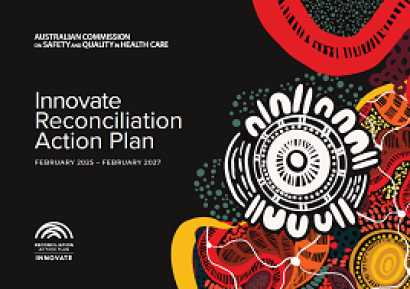Innovate Reconciliation Action Plan
The Commission's Reconciliation Action Plan (RAP) is a first step towards reconciliation and importantly, improving the safety and quality of health care for Aboriginal and Torres Strait Islander peoples in Australia.
Message from the CEO, Conjoint Professor Anne Duggan
I am exceptionally proud to present the Australian Commission on Safety and Quality in Health Care’s (the Commission’s) Innovate Reconciliation Action Plan 2025-2027.
This is the Commission’s second Reconciliation Action Plan (RAP) and continues the momentum of our Reflect RAP. Our Innovate RAP identifies strategic actions and goals for the Commission for the next two years to promote reconciliation, contribute to equitable health outcomes and the elimination of racism.

The Commission has thoughtfully built a welcoming, open, and supportive organisational culture that proudly celebrates diversity among staff and values the knowledge and strength of Aboriginal and Torres Strait Islander peoples and their cultures. We collaborate and work in partnership with Aboriginal and Torres Strait Islander organisations and peoples to lead and coordinate safety and quality improvements for the Australian healthcare system.
Participating in Reconciliation Australia’s Reconciliation Action Plan Program has enabled the Commission to develop a framework for a whole-of-organisation approach to reconciliation by fostering cultural awareness, cultural responsiveness, and cultural safety. We have identified sustainable, meaningful, and impactful ways forward for reconciliation in our work and daily lives.
On our reconciliation journey, the Commission commits to increasing staff knowledge of Aboriginal and Torres Strait Islander cultures and traditions and continuing to seek opportunities to enhance and grow our staff’s cultural learning journey.
Anne Duggan
Our Reconciliation Action Plans
Reflect RAP (August 2022 – August 2023)
The Reflect-type RAP is the first of four stages – Reflect, Innovate, Stretch and Elevate. Each stage supports continuous strengthening of reconciliation commitments in new ways. The aim of the Commission's Reflect RAP was to increase the capability, resources and events across our organisation for staff to learn, form partnerships and innovate to improve the experience of care for Aboriginal and Torres Strait Islander people across Australia.
About the artwork
A Journey Through Change (2024)
Kylie Hill I Kalkadoon (Mount Isa) and Waanyi (Far North Queensland)
Our journey pathway to change are the tracks and meeting place that represents our commitment to one another including being more empathetic towards our work colleagues and community members. It helps us to understand the challenges of change with compassion and dedication to reconciling our differences.
Our overlay of the meeting place and song lines reminds us to make a connection and commitment to understanding change by making a difference. Moving forward and establishing positive relationships and committing to these changes.
Our oldest cultural symbols represent our journey of change, which strengthens and empowers reconciliation. The sun represents the warmth of light that shines on us through our darkest days. The coolamon carries life and the good tucker we need to keep our strength on our life's journey. The DNA symbols represent our genetic diversity and is a stepping stone to building relationships. The dillybag holds the medicine leaves we need to keep ourselves healthy for the future. Our journey tracks represent building our reconciliation pathway together.
All symbols in our journey through change create a powerful message that brings about actions that strengthens relationships and growth while establishing the best approach for a powerful influence in achieving reconciliation in the workplace.
Kylie Hill
This document has been designed by Smyth Studio, a 100% Indigenous owned and Supply Nation Certified business.

